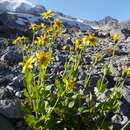Description
provided by eFloras
Plants 10–30 cm. Stems (often 5–10 in dense clumps) branched distal-ly. Leaves 2–3 pairs, mostly cauline (basal leaves often persistent on sterile rosettes, similar to cauline leaves); petiolate (petioles narrowly to broadly winged, distal pair of leaves often reduced, connate-perfoliate); blades ovate to ovate-lanceolate, 2–6 × 1–3 cm, margins irregularly serrate to subentire, apices acute, faces: abaxial glandular, adaxial stipitate-glandular. Heads (1–)5–15. Involucres turbinate-campanulate. Phyllaries 10–16, ovate-lanceolate. Ray florets 5–12; corollas yellow. Disc florets: corollas yellow; anthers yellow. Cypselae black, 4.5–7 mm, hairy (hairs duplex) and stipitate-glandular; pappi white, bristles barbellate. 2n = 57, 76.
- license
- cc-by-nc-sa-3.0
- copyright
- Missouri Botanical Garden, 4344 Shaw Boulevard, St. Louis, MO, 63110 USA
Synonym
provided by eFloras
Arnica latifolia Bongard var. gracilis (Rydberg) Cronquist
- license
- cc-by-nc-sa-3.0
- copyright
- Missouri Botanical Garden, 4344 Shaw Boulevard, St. Louis, MO, 63110 USA
Comprehensive Description
provided by North American Flora
Arnica gracilis Rydb. Bull. Torrey Club 24: 297. 1897
''Arnica ovalifolia Greene. Pittonia 4: 168. 1900.
Arnica betonicaefolia gracilis M. E. Jones, Bull. Univ. Mont. Biol. 15: 48. 1910.
Rootstock horizontal; stem 1.5-3 dm. high, glabrate below, glandular-puberulent above; basal leaves and lower stem-leaves petioled, the petioles 1-4 cm. long; blades ovate, 3-ribbed, 1-4 cm. long, dentate, minutely glandular-puberulent or glabrate, except the ciliolate margins; stem-leaves 2 or 3 pairs, the upper ones sessile, lanceolate or ovate, small; heads 1-3, rarely 5; peduncles 3-8 cm. long; involucre turbinate, 8-10 mm. high and as broad, glandular-granuliferous, sometimes with a few hairs; bracts 10-12, oblanceolate, acuminate; ray-flowers 8-10, the ligules about 12 mm. long, 4 mm. wide, bluntly 3-toothed; disk-corollas 5-6 mm. long; achenes 5 mm. long, hirsute; pappus-bristles 6 mm. long, white, barbellate.
Type locality: Spanish Peaks. Montana. Distribution: Mountains of Montana and Wyoming.
- bibliographic citation
- Per Axel Rydberg. 1927. (CARDUALES); CARDUACEAE; LIABEAE, NEUROLAENEAE, SENECIONEAE (pars). North American flora. vol 34(4). New York Botanical Garden, New York, NY
Arnica gracilis: Brief Summary
provided by wikipedia EN
Arnica gracilis is a North American species of flowering plant in the family Asteraceae, known by the common name smallhead arnica. It is native to western Canada (Alberta, British Columbia) and the northwestern United States (Washington, Oregon, Idaho, Montana, Wyoming, north-central Colorado (Jackson County), and northern Utah (Cache, Summit, + Daggett Counties).
Arnica gracilis is an herb up to 30 cm (12 inches) tall. Flower heads are yellow, with both ray florets and disc florets.
- license
- cc-by-sa-3.0
- copyright
- Wikipedia authors and editors

